
Very Large Land Based Optical Telescopes
The Hobby–Eberly Telescope In Texas
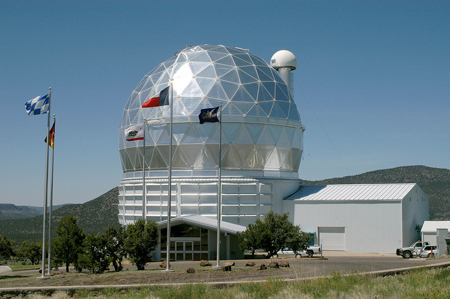
A very large telescope (in this discussion) means one with at least an 8 meter (26-foot) aperture. (In optics, an aperture is an opening through which light travels.) The Hobby–Eberly Telescope (HET) is a 10-meter optical telescope located at the McDonald Observatory at Fort Davis in Jeff Davis County, West Texas. (An optical telescope is a telescope in the human eye visibility range as opposed to those in the gamma ray, x-ray and radio frequency ranges.) The observatory is part of the University of Texas at Austin. It is one of the largest optical telescopes in the world. The telescope is named for former Texas Lieutenant-Governor Bill Hobby and for Robert E. Eberly, a Penn State benefactor.
HET has a number of features that differentiate it from most telescope designs which resulted in much lower construction costs. The primary mirror is constructed from 91 hexagonal segments (a segmented mirror is an array of smaller mirrors designed to act as a single large curved mirror. A segmented mirror is less expensive than a single large primary mirror. The main mirror is fixed at a 55° angle and can rotate around its base. A target is tracked by moving the instruments at the focus of the telescope. This provides access to about 70% to 80% of the sky at its location and allows a single target to be tracked for up to two hours.
Three instruments are available to analyze the light from the targets. All three instruments are spectrographs (a spectrograph is an instrument that separates light into its frequency spectrum and records the result with a camera). The three instruments work at high, medium and low spectral resolution. The low-resolution spectrograph is housed at the signal focus, while the medium and high-resolution spectrographs reside in the basement and the light is fed into them via a fiber-optic cable.
Since achieving first light in 1996, the telescope has been used for a wide variety of studies ranging from the Solar System to stars in our galaxy and studies of other galaxies. The telescope has been used successfully to find planets orbiting around other stars by measuring radial velocities as precisely as one meter per second. Using the low-resolution spectrograph, the telescope has been used to identify Type Ia supernovas to measure the acceleration of the universe. The telescope has also been used to measure the rotation of individual galaxies. The telescope was recently upgraded for use in the Hobby–Eberly Telescope Dark Energy Experiment (HETDEX), which will provide the first observations to allow narrowing of the list of possible explanations for dark energy. Top
The Large Binocular Telescope In Arizona
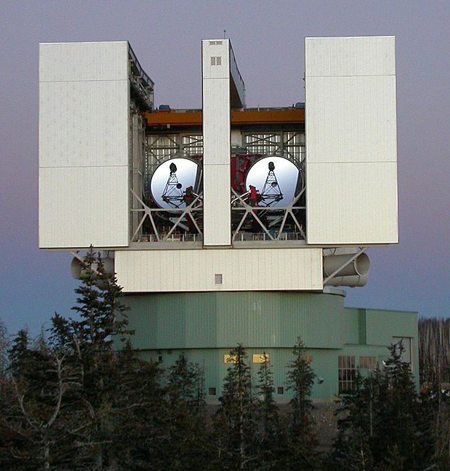
The Large Binocular Telescope (LBT) is an optical telescope located on 10,700-foot (3,300 meters) Mount Graham, in the Pinaleno Mountains of southeastern Arizona. It is a part of the Mount Graham International Observatory. The LBT is currently one of the world's most advanced optical telescopes; using two 8.4 m (27 ft.) wide mirrors, with centers 14.4 m apart. It has the same light-gathering ability as an 11.8 m (39 ft.) wide single circular telescope and the detail of a 22.8 m (75 ft.) wide one, which is greater than any other single telescope.
The LBT mirrors individually are the second-largest optical mirrors in North America (excluding Hawaii), behind the Hobby–Eberly Telescope in Texas. It is also the largest monolithic (non-segmented mirror) in an optical telescope. The telescope was dedicated in October 2004 and saw first light with a single primary mirror in October 2005. The second mirror was installed in January 2006 and became fully operational in January 2008. The two mirrors are mounted on a common base, hence the name "binocular".
LBT takes advantage of active optics provided by the Arcetri Observatory in Italy. Active optics is a technology used with reflecting telescopes which actively shapes a telescope's mirrors to prevent deformation due to external influences such as wind, temperature, and mechanical stresses. Without active optics, the construction of 8 meter class telescopes is not possible, nor would telescopes with segmented mirrors be feasible
The choice of location sparked considerable local controversy, both from the San Carlos Apache Tribe who view the mountain as sacred, and from environmentalists who contended that the observatory would cause the demise of the endangered Mount Graham Red Squirrel. Environmentalists and members of the tribe filed some forty lawsuits, eight of which ended up before a federal appeals court. However, the project ultimately prevailed after an act of Congress. The telescope and mountain observatory survived two major forest fires in eight years, the more recent in the summer of 2004. Likewise the squirrels continue to survive. Some experts now believe their numbers fluctuate dependent upon nut harvest without regard to the observatory. Top
Gemini North Telescope In Hawaii
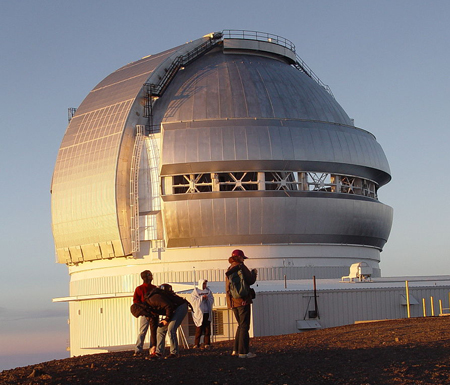
The Gemini Observatory is an astronomical observatory consisting of two 8.2-meter (27 ft.) telescopes, the Gemini North and Gemini South at different sites in Hawaii and Chile. Together, the two telescopes cover almost all of the sky except for two large regions near the poles. It is estimated that the two telescopes cost approximately $184 million to construct, and a night on each Gemini telescope is worth about $33,000. They are currently among the largest and most advanced optical/infrared telescopes available to astronomers.
The Gemini telescopes were built and are operated by a consortium consisting of the United States, Canada, Chile, Brazil, Argentina, and Australia. This partnership is managed by the Association of Universities for Research in Astronomy. The United Kingdom dropped out of the partnership at the end of 2012. The Gemini Observatory responded to this by significantly reducing its operating costs during 2012 so that no new partners were required.
The Gemini Observatory's international "Headquarters" is located in Hilo, Hawaii at the University of Hawaii. The "Gemini North Telescope", is located on Hawaii's Mauna Kea, along with other telescopes. Mauna Kea provides excellent viewing conditions due to the superb atmospheric conditions (stable, dry, and rarely cloudy) above the 4,200 meter high (13,800 ft.) dormant volcano. It saw first light in 1999.
In addition to very advanced optical observations, the Gemini telescope allows very high quality infrared observations due to the advanced silver coating of its mirrors, its small secondary mirror, and advanced ventilation systems. Thanks to a high degree of networking, the Gemini telescopes can be operated remotely. Observations can be run when atmospheric conditions suit them best, reducing travel for astronomers. Top
The Keck Telescopes In Hawaii
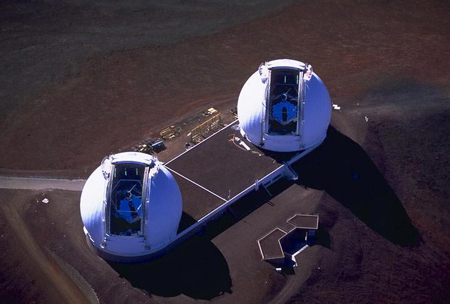
The W. M. Keck Observatory is a two-telescope observatory at an elevation of 4,145 meters (13,600 ft.) near the summit of Mauna Kea in Hawaii. Both telescopes feature 10 meter (33 ft.) primary mirrors, currently the largest optical telescopes in use. See the two Keck photos to the left. The telescopes are equipped with a suite of instruments that allow observations across both the visible and near infrared spectrums. The combination of an excellent site, large optics and innovative instruments has created the two most scientifically productive telescopes on earth.
With a concept first proposed in 1977, telescope designers at the University of California (Terry Mast) and Lawrence Berkeley Labs (Jerry Nelson) developed the technology to build a very large, ground based telescope. In 1985, Howard B. Keck (of the W. M. Keck Foundation) gave $70 million to fund the construction of the Keck I telescope.
Construction of Keck I began in September, 1985, with first light occurring in November 1990 using only nine of the eventual 36 segments. With construction of the first telescope well advanced, further donations allowed the construction of a second telescope starting in 1991. The Keck I telescope began science observations in May 1993, while first light for Keck II occurred in October, 1996.
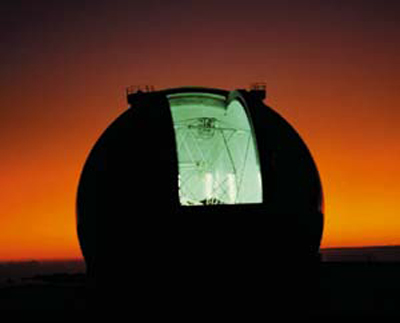
The key advance that allowed the construction of the Keck large telescopes was the ability to operate smaller mirror segments as a single, contiguous mirror. Each of the primary mirrors is composed of 36 hexagonal segments that work together as a single unit. On the telescope, each segment is kept stable by a system of active optics, which uses extremely rigid support structures in combination with three actuators under each segment .A segment is 1.8 meters wide, 7.5 centimeters thick, and weighs half a ton. The total weight of each telescope is more than 300 tons.
The mirrors were made from glass-ceramic by the German company Schott AG. During observation, the computer controlled system of sensors and actuators adjusts the position of each segment, relative to its neighbors, to an accuracy of 4 nanometers (4 billionths of a meter). This twice-per-second adjustment counters the effects of gravity (as the telescope moves) in addition to other environmental effects (temperature, wind, etc.) that can distort the mirror's shape. The Keck telescopes are the largest steerable, optical/infrared telescopes on earth. Top
Major Outer Space Telescopes
The Hubble Space Telescope
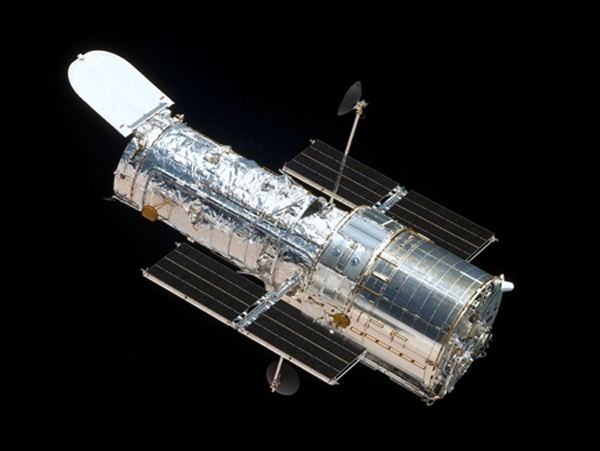
The Hubble Space Telescope (HST) was launched into low earth orbit in 1990, and remains in operation to this day. Hubble is one of the largest and most versatile space telescopes. It is well known as both a vital research tool and a public relations boon for astronomy. The HST is named after astronomer Edwin Hubble, and is probably the greatest observatory to date.
The HST was built by NASA, with contributions from the European Space Agency. The Space Telescope Science Institute selects Hubble's targets and processes the resulting data. The Goddard Space Flight Center controls the spacecraft.
Hubble was funded in the 1970s, with a proposed launch in 1983, but the project was delayed by technical issues, budget problems, and the Challenger disaster (1986). When finally launched in 1990, Hubble's main mirror was found to have been ground incorrectly, compromising the telescope's capabilities. The optics were corrected to their intended quality
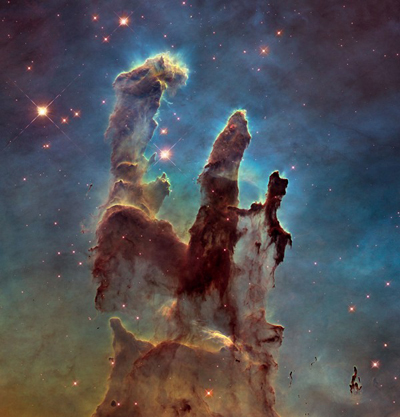
level by a NASA Space Shuttle servicing mission in 1993.
Utilizing a 2.4-meter (7.9 ft.) mirror, Hubble's four main instruments observe in the near ultraviolet, visible, and near infrared spectra. Hubble's orbit outside of the earth's atmosphere allows it to take extremely high resolution images, with substantially lower background light than ground based telescopes.
Hubble has recorded some of the most detailed visible light images ever, allowing a deep view into space and time. See the very famous "Pillars" photo to the left. Many Hubble observations have led to breakthroughs in astrophysics, such as accurately determining the rate of expansion of the universe.
Hubble is the only telescope designed to be serviced in space by astronauts. After launch by the Space Shuttle "Discovery" in 1990, five subsequent Space Shuttle missions upgraded and replaced sub-systems on the telescope, including all five of the main instruments.
The fifth mission was canceled on safety grounds following the Columbia disaster in 2003. However after much public discussion, the NASA administration approved the fifth servicing mission which was completed in 2009. The telescope is operating as of 2018, and could possible last until 2040. Top
X-Ray Telescopes:
Chandra X-ray Observatory

The Chandra X-ray Observatory is a "Flagship" best in class space observatory launched in July, 1999. Chandra is sensitive to x-ray sources 100 times fainter than any previous x-ray telescope, enabled by the high angular resolution of its mirrors.
The telescope is named after Indian American astrophysicist Chandrasekhar who won the 1983 Nobel Prize in Physics for his theoretical work on the evolution of massive stars and black holes.
Since the earth's atmosphere absorbs the vast majority of x-rays, they are not detectable from earth based telescopes. Therefore, space based telescopes are required to make x-ray observations. As of early 2017, Chandra's mission is ongoing (now almost 18 years).
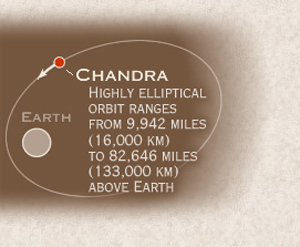
NASA began work on the Chandra X-ray satellite in 1976 and continued throughout the 1980s and 1990s. In 1992 to reduce costs, the spacecraft was redesigned. Four of the twelve planned mirrors were eliminated, as were two of the six scientific instruments.
The planned orbit was changed to an elliptical one, reaching one third of the way to the Moon's at its farthest point. See the 64 hour orbit illustration to the left. This eliminated the possibility of improvement or repair by the space shuttle, but put the observatory above the Earth's dangerous radiation belts for most of its orbit.
Chandra has been returning data since the month after it launched. It is operated by the Chandra X-ray Center in Cambridge, Massachusetts, with assistance from MIT and Northrop Grumman Space Technology.
Chandra was initially given an expected lifetime of 5 years, but NASA has extended its lifetime to 18 plus years "based on the observatory's outstanding results". Chandra has made over 25 major discoveries and continues to amaze astrophysicists. Top
NuSTAR X-ray Telescope
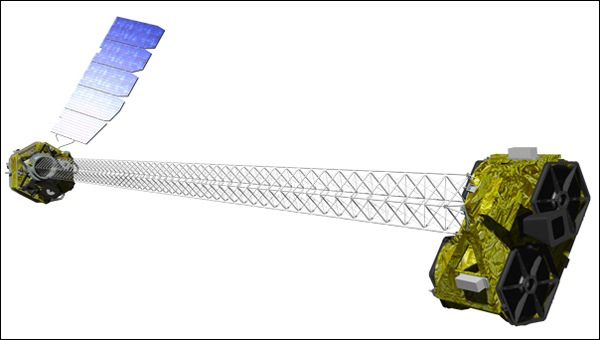
NuSTAR (Nuclear Spectroscopic Telescope Array) is a space-based x-ray telescope that focuses on very high energy x-rays from outer space sources. NuSTAR operates in the range of 6 keV (thousands of electron volts) to 79 keV, energies well beyond those of Chandra. It was successfully launched in June, 2012.
X-ray telescopes are rather lengthy because of the need to focus the x-rays. Normal reflecting mirrors do not work for x-rays. X-rays mirrors can be built, but only if the angles from the planes of reflection are very low, resulting in a lengthy telescope. The mirrors are called glancing (or grazing) mirrors. NuSTAR's length in space is roughly 10 meters (33 ft.). It is compacted during take off and assembled to its design length once in its proper orbit.
NuSTAR's primary scientific goals are to conduct a deep survey for black holes a billion times more massive than the sun, to investigate how particles are accelerated to very high energy in active galaxies, and to understand how elements are created in the explosions of massive stars by imaging the remains (called supernova remnants). After its primary mission of 2 years, NuSTAR is now in a 3-year mission extension to 2017. NASA has not forecasted how long they expect it to be active.
In January 2005, NASA designated NuSTAR for flight. However, the program was cancelled in February, 2006 as a result of cuts to science in NASA's 2007 budget. In September, 2007 it was announced that the program had been restarted with an expected launch in August, 2011. This was later delayed to June, 2012. The principal investigator is Fiona Harrison of the California Institute of Technology (Caltech).
Markarian Corona Movement. In August, 2014 NASA's NuSTAR captured an extremely rare event in the region immediately surrounding super massive black hole Markarian (Mrk) 335. The corona, a compact source of x-rays that sits above and close by the black hole, had moved closer to the black hole due to the pull of the black hole's gravity over a period of just a few days. The exact shape and nature of coronas are not known.
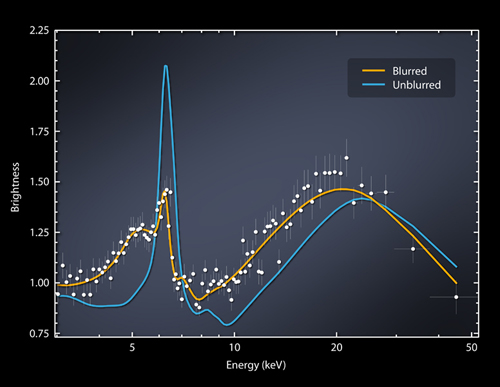
As the corona shifted closer to the black hole, the gravity of the black hole exerted a stronger tug on the x-rays emitted by it. The result was an extreme blurring and stretching of the x-ray light. Such events had been observed previously but never to this degree and in such detail.
The plot of Mrk 335 data to the left, captured by NuSTAR, shows x-ray light streaming from regions near the super massive black hole. The x-ray light is coming from two areas: the superheated disk of accretion material and a cloud of particles traveling near the speed of light originating from the corona.
The accretion disk's and corona's x-ray light are mapped over a range of energies. The blue line shows what the plot should look like before the effects of the moved corona. The yellow line shows what the data is predicted to look like if the "corona" x-ray light has been stretched or blurred. The white dots show the actual NuSTAR data, indicating the light is extremely blurred and as predicted. What's blurring the light? The enormous gravity of the black hole pulls on the x-ray light, making it harder to escape its grasp and in the process the light loses some energy. Top
Gamma Ray Satellites:
The Swift Satellite
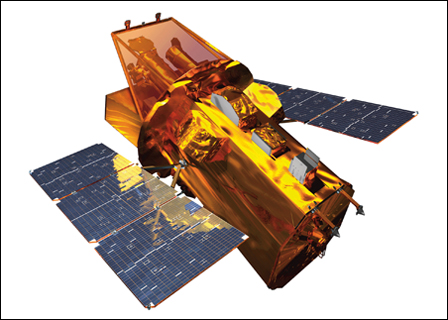
The Swift satellite was launched in 2004 with a mission to quickly detect Gamma Ray Bursts (that frequently have very short life cycles) with its Burst Alert Telescope (BAT). Also part of its mission is to quickly adjust its two telescopes to locate the GRB and capture not only the blast, but also the after glow. Within seconds of detecting a burst, Swift relays its location, allowing both ground-based and space-based telescopes around the world to observe the burst and its afterglow.
To track these mysterious bursts, Swift carries a suite of three main instruments. The Burst Alert Telescope (BAT) instrument, built by the Goddard Space Center, will detect and locate about one gamma-ray burst a day, relaying a rough position to the ground within 20 seconds. The satellite will swiftly re-position itself to bring the burst area into the narrower fields of view of the on-board X-ray Telescope (XRT) and the Ultraviolet/Optical Telescope (UVOT). These telescopes study the afterglow of the burst produced by the cooling ashes that remain from the original gamma ray explosion.
The XRT and UVOT instruments determine a precise position of the burst and measure the spectrum of its afterglow from visible to X-ray wavelengths. For most of the bursts detected, Swift data, combined with complementary observations by ground-based telescopes, will enable the measurement of the distance to the burst source. The afterglow phenomenon can linger in X-ray light, optical light, and radio waves for hours to weeks, providing detailed information about the burst. Swift will check in on bursts regularly to study the fading afterglow as will ground-based optical and radio telescopes. The crucial link is having a precise location to quickly direct other telescopes to the burst. Top
The Fermi Satellite
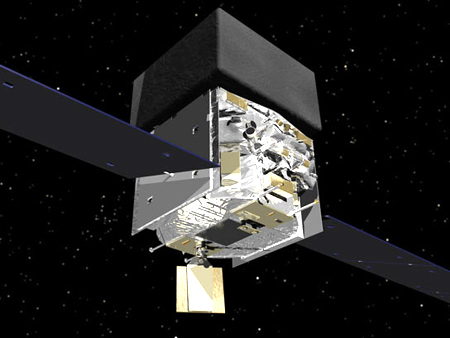
The Fermi satellite was launched in June 2008 to complement the Swift satellite launched in 2004 with a more sophisticated set of instruments. It was originally called GLAST, the Gamma-ray Large Area Space Telescope. It was renamed Fermi in August, 2008 in honor of Enrico Fermi, a pioneer in high-energy physics. Fermi catches photons with energies hundreds of billions of times greater than those that we see with our eyes.
Fermi's overall mission is to to perform gamma ray research from a low circular satellite orbit. It circles the earth every 95 minutes or about 16 times a day. Its normal mode of operation keeps an orientation so that the instruments look away from the earth with a rocking motion to sweep across the sky. The spacecraft can also maintain an orientation that points to a given target.
Fermi contains two major instruments: the Large Area Telescope (LAT) and the Gamma-ray Burst Monitor (GBM). The main instrument, the gamma-ray LAT, is vastly more capable than instruments in previous satellites. The LAT, has a superior area, good angular resolution, and a large field of view, that all together provides at least a factor of 30 times improvement in sensitivity. It also has the capability to study transient phenomena, such as solar flares. The LAT's field of view covers about 20% of the sky at any time and it scans continuously, covering the whole sky every three hours.
Fermi also has a secondary instrument to augment the LAT - the Gamma-ray Burst Monitor (GBM) . The purpose of the GBM is to determine that a GRB has been detected, to quickly calculate the exact coordinates of it, and to immediately pass the location on to the LAT. The Gamma-ray Burst Monitor has a field of view several times larger than the LAT and extends the lower energy limit of the LAT coverage. Its detectors are on the sides and top of the spacecraft in order to view all of the sky which is not blocked by the earth.